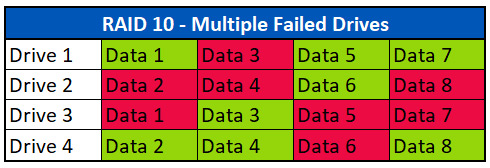While the RAID system overall makes it possible to optimise data storage by distributing it over several hard disks, each configuration has its own advantages.
RAID 10 requires at least 4 drives and creates a RAID 1 mirror of one RAID 0 array to another RAID 0 array. This configuration gives the user redundancy or fault tolerance without sacrificing read and write speeds. The drawback to this RAID configuration is the cost, as you need to have twice as many disks.
Read below to get a better understanding on how it works and its various advantages. We will also compare it with another type of configuration, RAID 5, which is widely used in servers.
RAID 10: A powerful and reassuring combination
A RAID array is a collection of multiple disks that are configured either by software or a hardware controller in a certain way to protect data or enhance performance. RAID stands for a redundant array of independent disks. There are many different types of RAID arrays which affect read and write speeds as well as redundancy or fault tolerance.
RAID 10 requires at least 4 drives and is a combination of RAID 1 and RAID 0. RAID 1 is a set of two hard drives, one of which is mirrored to secure the stored data. This cloning system has a high fault tolerance and is therefore suitable for storing sensitive data. RAID 0 is a system that distributes information stored on multiple hard drives by interweaving data, meaning the access time is accelerated. In the example below, Disk 1 and Disk 3 are in a RAID 1 configuration or a mirror. Disk 2 and Disk 4 are also in a RAID 1 configuration. The data is then striped across the 2 mirror sets in a RAID 0 configuration. Giving the user the protection of a RAID 1 with the speed of a RAID 0.

There is the reverse which is called RAID 01, but the configuration is basically the same, it is a stripe set (RAID 0) mirrored to another stripe set (RAID 0) in a RAID 1 configuration.
What are the data recovery options for RAID 10?
RAID 10 systems allow for the recovery of data in the event of a loss in a couple different ways. If one of the drives in either mirror set fails, the system should fail over to the secondary member. This allows the user to continue to use the system without interruption. The failed drive can then be replaced with a new drive and remirrored to the secondary drive. Newer RAID 10 controllers, will even allow a second drive failure to occur without bringing down the storage, provided the second failure occurs on the second mirror set.
If that failover doesn’t work, or both drives report failures, Ontrack can assist. Using our advanced clean room technologies, the Ontrack team will attempt to image the drives.
If one of the drives from each mirror set images without errors, the Ontrack team will use that data to rebuild the logical volume and recover the data. In the image below, Drive 2 failed, so Ontrack could use Drive 1 and Drive 4 to rebuild the file system and recover the data.

If two drives fail from different RAID 1 arrays, the Ontrack team can use the mirrors to rebuild the RAID 10 array virtually and recover the volume. In the image below, Drive 2 and 3 failed. The Ontrack team would use Drives 1 and 4 to rebuild the array. Once the array is built, the file system is assembled, and the data can be extracted.

Even if all 4 drives fail, recovery is still possible. In the image below, we see an example of a 4 drive failure. In this case, Ontrack would use portions from all 4 drives to virtually rebuild the array and recover the data.

Note: RAID 10 only protects against drive failures and does not protect against malware, deletions or corruption like a backup does. RAID 10 also has a significantly higher cost per GB as the number of drives needs to be doubled when compared against RAID 5 or RAID 6 arrays.


 Singapore | English
Singapore | English
 Locations
Locations
 Search
Search




 Back to listing
Back to listing









